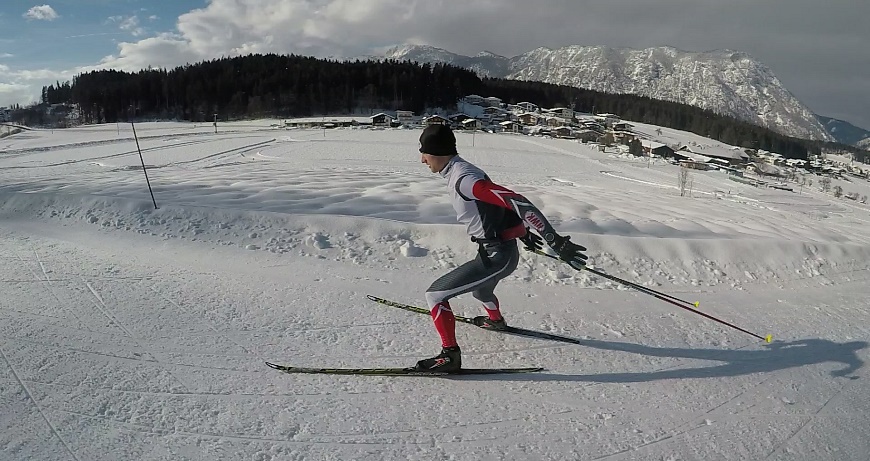Visiting the Mariandlalm in Thiersee

Active & nature
Visiting the Mariandlalm in Thiersee
By the end of the season, I will have run over 1,000 kilometres on local trails. By the way, the more I did cross-country skiing in winter, the easier was the upcoming racing season on the bike.
This leads me to the fist item:
Cross-country skiing is probably the best winter training for cyclists. Why? It’s a highly intense training for the whole body: shoulders, torso and legs. Properties such as strength, endurance, explosiveness, stability and the ability to suffer are trained. Other stimuli make the body more resistant and versatile.
Leaving the bike untouched in the corner clears your head. But you can’t do without it: If you want to benefit from cross-country skiing (or any other alternative sport in winter) in summer, then you should pedal hard after each cross-country skiing session up to one hour. Due to enduring physical training you don’t build up unnecessary muscles but gain power and stability without putting on weight.
Stability is also the next keyword. Keeping the balance on skinny skies is very difficult for beginners. In addition there are long gliding phases, requiring a good body control. That’s an advantage for any sport. Especially for cycling, stability brings more safety, agility and responsiveness in downhills and on the road. Last year, I also gave you an insight into the world of "Stabi or core training". Cross-country skiing is the best outdoor training for this sort of sport. Nevertheless, you should still practice the normal "Stabi or core training" at home or at the gym.
Most important in cross-country skiing is the technique. My first attempts must have looked terrible. Fortunately, I had good instructors teaching me the optimal techniques. Therefore, I constantly improved. You need about three years to learn technically good skate skiing. Then you can begin to refine your curve techniques and downhills. A very complex sport that, once you have learned it, makes you very happy.
That is a multifunctional skate movement. Ensuring more balance, you can use is uphill as well as on flat terrain.
By simultaneously using the poles and gliding your skies you develop more power while skating uphill. By doing so, widely extend your legs to avoid slipping. This uphill skate movement is hard training for your legs.
As to the other two movements the skis almost glide straight forward to build up speed. Another difference is that the pole push only occurs during the gliding phase.
You make two skate movements and one pole push. This step is only used in flat terrain, as it would not make sense uphill. It is also called "long skate movement" because the glide phase is a long one. This means you can glide the leading ski for a longer time, that’s why it’s used in flat terrain and at fast conditions.
The 1/1 skate movement:
A skate movement and a pole push. Mainly used in flat terrain, but also for light to medium climbs. Very exhausting movement.
Of all the steps I use the 1/1 the most. But that is individually different.
However, one rule applies to all techniques: The poles are skipped to the rear during the pole push. If you don’t follow this rule, you would cut off half of the momentum and loose too much energy. (See picture "pole push")
There are skis for different weight classes. The heavier you are, the more tension the ski needs, so that the rebound motion of the ski "swings back." Otherwise, you would move forward slowly.
The length of the poles and skies must be well chosen, whereas the poles are considerably longer than the alpine poles. Please don’t use these ones ... that would look ridiculous.
The ski coating is adapted to the surface condition. That’s why there are coatings for cold, warm or universal grounds.
As in cycling you should take your time to find the perfect equipment. Please be careful when choosing the cross-country ski boots since they shouldn’t be too large. Exception applies only if you always have cold feet and run with wool socks ... As to me: I have always cold feet, but never while cross-country skiing.
Please be careful when it comes to clothing. Since you mostly run when temperatures are below freezing, you usually feel colder due to the speed. That's why I dress as follows:
To start you have to invest some money in equipment and clothing. Quality pays off. Especially at the beginning you can use your cycling clothing if available (eg. windbreakers, thermal jackets and pants, long-sleeve jersey etc.).
Finally, I suggest to look for an experienced cross-country skier who can instruct and train you. I can tell you that you won’t get far with video studies and the like ... I speak from my own experience. Once you get on your cross-country skis and make your first skate movements, you will see that the rest comes naturally - fun factor included.
0 Comment (s)
More comments